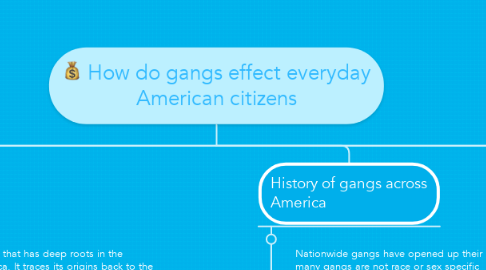How do gangs effect everyday American citizens
by Deaven Knowles

1. Dangerous gangs in America
1.1. The Mexican Mafia is a gang that has deep roots in the penitentiary system of America. It traces its origins back to the 1950’s and back then it was largely centered in the California Department of Corrections.
1.2. Unlike other gangs mentioned in this piece, the Aryan Brotherhood organization is a gang that has a major stronghold in the federal penitentiary system of the United States. According to the FBI, the gang’s members make up less than 0.1% of the prison population, but they account for 20% of all the murders that happen in jails across the United States.
2. Gangs in social media
2.1. We hear a lot about an epidemic rise in youth crime. The truth is, youth crime has always been a part of society
2.2. Much of the reported rise in youth crime is in direct relation to the huge population increase in recent decades and, crucially, in the way the media choose to report youth crime.
2.3. Gang enforcement officers in Chicago started looking closely at social media sites about three years ago, after learning that high school students were filming fights in the hallways and alcoves of their schools and posting the videos online..
2.4. Much of this police work is reactive. In the same way that flyers taped to light poles used to announce parties, news of a big gathering is now posted online, and officers move into position based on that intel.
3. History of gangs across America
3.1. Nationwide gangs have opened up their ranks; many gangs are not race or sex specific anymore.
3.2. The first active gangs in Western civilization were reported by Pike (1873, pp. 276–277), a widely respected chronicler of British crime.
3.3. The Southern region18 emerged much later as an important gang territory.
4. gang violence
4.1. Based on evidence from federal, state, local, and tribal law enforcement, the FBI says gangs commit 48% of violent crime, and are only becoming more dangerous.
4.2. According to the 2011 National Gang Threat Assessment report, gangs are responsible for an average of 48 percent of violent crime in most jurisdictions, and up to 90 percent in others
4.3. We don’t see a drop in the key gang magnitude indicators,” James Howell of the National Gang Center said. -“In the past five years we’ve seen an 8 percent increase in number of gangs, an 11 percent increase in members and a 23 percent increase in gang-related homicides.
5. Definition of a gang
5.1. "A gang is an interstitial group, originally formed spontaneously, and then integrated through conflict. It is characterized by the following types of behavior: meeting face to face, milling, movement through space as a unit, conflict, and planning. The result of this collective behavior is the development of tradition, unreflective internal structure, esprit de corps, solidarity, morale, group awareness, and attachment to a local territory.


